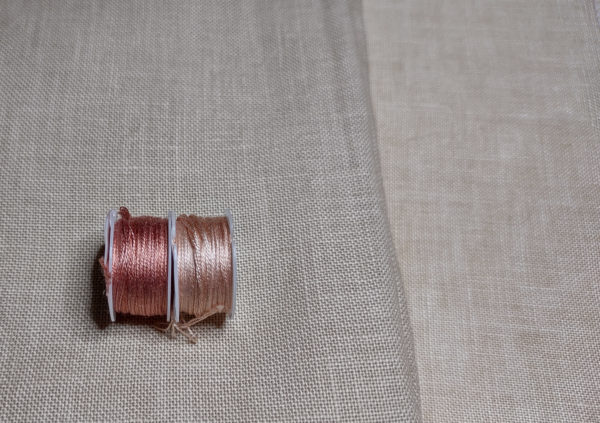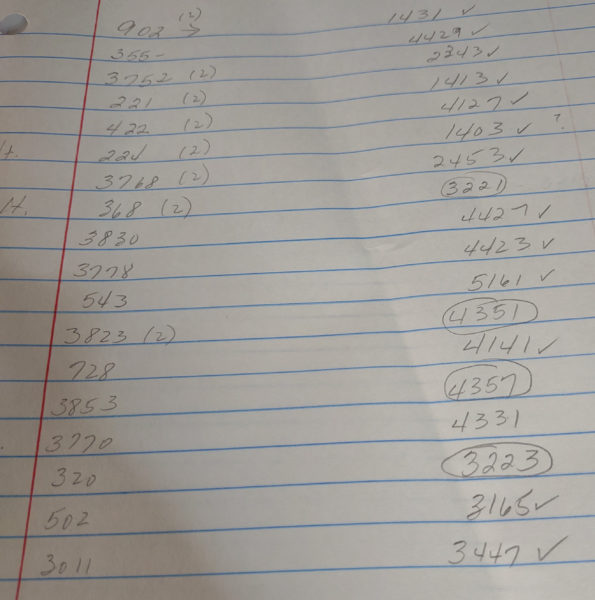A reader asked which Victoria Clayton silks I ordered for New Years Sampler. First, you know I am not terribly experienced with anything cross-stitch related but here are a few of my opinions I would like to share.
Maybe I’m wrong . . it has happened before <G>, but I think we should use the called for colors as a suggestion and not take them as the gospel or as the ONLY colors we can use.
We put so much time and often money into these projects. To me, it doesn’t matter so much what fabric color we choose but what matters most is how the floss colors work together on the fabric. Most of these designers can snap their fingers and the linen they want almost magically appears on their doorstep. Most of us lowly cross stitchers spend hours looking for the called for linen and never find it, especially if it’s one of the “chosen” brands that many of the designers recommend. Try finding R & R Linen, or Lakeside Linen . . good luck! Then see how many of the designers are using those. It really does frustrate me that so many of us can’t get our hands on the linens that are recommended and yet the designers continue to use those. When I was designing quilts for magazines, it was always stressed that I needed to use fabric that was currently available.
I do understand that linen dyers are having problems just like everyone else but there are linens that are much easier to find. The Scarlett House used Fox & Rabbit’s Baked Clay for A Changed World. That is very easy to find. It’s everywhere – online shops, Etsy shops. I could get almost any Fox & Rabbit fabric color any time. There are several lines of linen that are easy to find and several that are not and, my feeling only, but I feel like it’s almost a “class system”. Some can get the linen they want and some of us cannot. OK . . rant about available linen is over (for now). 🙂
The first thing I look for when starting a new project is how much white or very light is in the chart. If there’s snow or Santa’s beard, that needs to stay white or close to white so I can rule out a very light fabric. Same goes for tans. If there are 4 or 5 shades of tan floss, I can rule out most of my tan stash because those colors are going to blend. For the most part, almost all the fabric I’m stitching, the linen comes from the stash and is rarely the called for linen so there almost always has to be some tweaking of colors.
Even if I am using the called for linen, different dye lots can produce different colors as can different thread counts of linen.

This is a photo from yesterday. These two linens are the same color in name . . not so much in reality. On the left is 36 count. On the right is 40 count. They’re probably different dye lots also. If I’m using 40 count and have excellent color choices for my floss, and you’re using the 36 count on the left, some of my color choices may not be perfect for you.
My advice is to choose your fabric first because fabric is the hardest to get most of the time, and it’s the most expensive. Once I have my fabric, I lay out all the DMC floss, assuming the chart lists DMC floss as an option. Always remember that 6 strands of floss is going to be more bold or vivid on your fabric than it will be when there are just one or two strands. When I see stitchers doing the “floss toss” (spreading out the DMC in the skein) to decide the colors, I always wonder how that really works and if they end up having to do some adjusting because 1 strand definitely looks different than 8 yards of 6 strands all folded up together.
I now have all the DMC floss except the newest ones but before I had that, I would go to Hobby Lobby and pull the floss . . just please put it all back in the proper tray if you aren’t buying it. I’ve grabbed a skein out of the the tray only to get home and find it was in the wrong tray and thus, I have the wrong color.
Another option is to buy the DMC color book that has all the DMC colors. I think these can be found that are printed or have the actual floss.
Lay out all the DMC floss and try to separate a bit of one or two strands without messing up the skein. Decide if you want to go lighter or darker. Once you have all the colors you think look nice with your fabric, write those numbers down, then go to a conversion chart and choose the floss colors you would like to use.
Vikki Clayton has a “Knowledge Base” where she has multiple conversion options shown. That is what I used for my conversion for New Year Sampler. She also has quite a few “Packets” which are conversions for popular charts that she has already converted. I’ve found that she’s most helpful also if you send her a picture of the DMC required floss and let her know if there are any that you are concerned about their being too light or too dark.
When I’m looking at the colors, even though it definitely isn’t perfect depending on monitors or even light shining on my computer screen, if I come across a color that I’m not sure is going to work – maybe I feel I need a lighter or darker color, I’ll order a second color and make a note so that when the floss arrives, I don’t waste time trying to figure out why I have extra bobbins of floss. One bobbin is $3.00 at this time. Shipping is $4.00. It makes sense if I’m uncertain about the color to order a backup or two. It saves in the long run and it saves time.

This is an example I used yesterday. I was fairly sure the Fish Pepper 4417 was going to be too light for my fabric. I knew I had other peachy colors at home so I didn’t order a second skein. I chose the darker color on the left from my stash and it’s labeled as a “Mystery” color.
One caveat is that sometimes a color that may blend with the fabric is only used in the middle of other colors and, in that instance, it won’t matter. When I ordered the floss, I did not have the chart but now that I have it, I know that the “nude” color is used in two places on faces that are surrounded by other colors but it’s used on three little elves (right side, lower third), where it is not surrounded by other colors.
Having said all that, this is a screen shot of the floss I ordered.

One more point . . when you make your conversion, write it all down and stick it with your chart.

This is one I did for another chart. Make notes! Just a week or so after ordering the floss, I have to go back and see why I did what I did. Sometimes I’ve ordered floss for projects that won’t be done for months so the notes are most helpful.
This all sounds like a much more complicated process than it really is. Hope this helps.

Joyce says
Such good advice — I wrote down the conversion I used, then packed it in one of the boxes for the move! 🙂 I’ve got a piece of 32 ct ivory fabric arriving (which was one of the recommendations I found on the designer’s web page), but am thinking I’d like to stitch it on 36 or 40 ct. My thread arrived yesterday and they are beautiful! I think I may do a road trip up toward Jo to visit her cross stitch shop (about 2 hours from here). We’ll see. I may be tired of the road by the time this is all over.